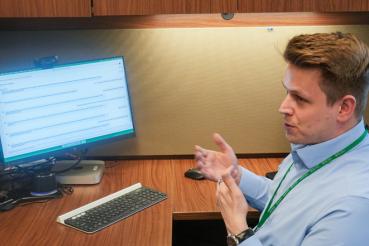If you're one of the 20,000 Americans who have amyotrophic lateral sclerosis (ALS), you know that it can be an overwhelming diagnosis. ALS, also known as Lou Gehrig's disease, is a progressive disease that attacks the nerve cells in the brain that control voluntary muscles. These are the muscles you can choose to move, as opposed to your heart, for example.
Its early symptoms include slurred speech, muscle weakness, twitching and cramping. Later, patients gradually become less able to move independently, swallow and breathe. On average, people with ALS live between two and five years after they're diagnosed.
While there is currently no cure for ALS, "there's a lot we can do to manage the symptoms and improve the quality of life," says Rabia Malik, MD, a neurologist at Rush.
"Our Neuromuscular Disease Program at Rush is made up of a team of dedicated providers who you will meet in our multidisciplinary clinic. We can help you understand what to expect and help you make difficult decisions regarding your care."
According to the American Academy of Neurology, people with ALS who are treated in a multidisciplinary clinic like the one at Rush receive better care and are more likely to live longer with a higher quality of life than those who don't have a care team.
Help with early ALS symptoms
Every case of ALS is different. Because it's a progressive disease, though, those who have it typically pass through a series of stages.
In its early stage, which can occur even before a diagnosis, ALS symptoms might include muscle weakness or stiffness, cramping, and loss of muscle mass in one or more regions of the body. Other symptoms can include fatigue, trouble with balance and slurred speech.
If you or a loved one experiences any of these issues, talk to your doctor, who can help determine the cause. Strategies and tools for this stage might include the following:
- Medical therapy such as the drug riluzole, which may be able to slow the progression of ALS somewhat, as well as medications that can help ease muscle cramps
- Physical and occupational therapy to help with strategies to deal with weakness in affected muscles
- Counseling and emotional support from a social worker, therapist and/or a monthly ALS support group
Treatments for middle-stage ALS
The middle stage of ALS is when symptoms become more widespread. Some muscles are weakened, while some are paralyzed. As the muscles used for swallowing weaken, some people experience choking, difficulty eating and excess salivation. Breathing can become difficult, especially when lying down. And a condition called pseudobulbar affect can cause uncontrolled laughing or crying.
Strategies and tools for this stage might include the following:
- Prescription medications to help with sleep problems, depression, anxiety, pseudobulbar affect and pooling saliva
- A dietitian's help with ensuring good nutrition and a speech therapist's techniques to manage speech and swallowing
- Physical therapy that teaches stretching exercises to relieve spastic muscles
- A brace fitted by an orthotist for any limbs that need support; a mobility specialist can also help choose a walking assistance device, e.g., a cane, walker or wheelchair
- A positive-pressure mask to wear at night or when shortness of breath is a problem
There's no medicine today that significantly affects the progression of ALS over the long term. But we have plenty of options that make the disease more manageable — and we [are] committed to giving patients the power to choose the interventions they want.
Options for the later stages of ALS
Late-stage ALS means that most voluntary muscles are paralyzed. Breathing is severely compromised, which can increase fatigue, confusion and susceptibility to pneumonia. Because swallowing muscles are paralyzed, it's no longer possible to eat or drink by mouth and can be difficult or impossible to speak.
Strategies and tools for this stage might include the following:
- A gastrostomy tube or G-tube that can be inserted through the abdomen to deliver nutrition directly to the stomach (maintaining good nutrition is critical to managing the progress of ALS).
- A ventilator when respiratory muscles begin to fail. Some people choose this intervention, while some choose to simply be made comfortable — it's a highly personal choice.
- Home-care equipment such as a hospital bed, power wheelchair and mechanical lift, as well as specially designed switches that enable control of household devices like computers and lights. A social worker can help arrange for these items.
Advances in ALS research and treatments
Researchers investigating ALS are making progress in a number of areas.
"It has become very clear that even though patients display similar pathologies, the underlying molecular and cellular causes are different," said a 2014 article in the journal ACS Medicinal Chemistry; "like cancer and heart disease, one drug and one solution to ALS is not the direction medicinal chemists should be heading."
Current research featured at a recent symposium hosted by the Chicago chapter of the ALS Association focuses on targeting treatments based on patients' differing genetics, and on identifying biomarkers — biological indicators that can be used to diagnose ALS early and measure how it reacts to a particular treatment.
In the meantime, symptom management strategies continue to improve.
"There are FDA-approved medications that help slow, but not stop, the progression of ALS," says Malik, "but there are several steps that can be taken to make the disease more manageable. We have a team here that's committed to giving patients the power to choose the interventions they want and support you and your families as you deal with this disease."




